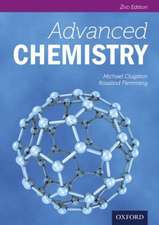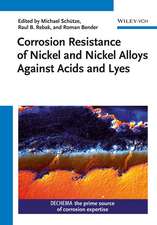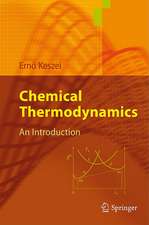From Simplicity to Complexity in Chemistry — and Beyond: Part I
Editat de Achim Müller, Andreas Dress, Fritz Vögtleen Limba Engleză Paperback – 11 iun 2012
Preț: 643.16 lei
Preț vechi: 756.65 lei
-15% Nou
Puncte Express: 965
Preț estimativ în valută:
123.09€ • 127.15$ • 102.44£
123.09€ • 127.15$ • 102.44£
Carte tipărită la comandă
Livrare economică 25 martie-08 aprilie
Preluare comenzi: 021 569.72.76
Specificații
ISBN-13: 9783642493706
ISBN-10: 364249370X
Pagini: 308
Ilustrații: XII, 295 p. 92 illus., 19 illus. in color.
Dimensiuni: 170 x 244 x 16 mm
Greutate: 0.49 kg
Ediția:Softcover reprint of the original 1st ed. 1996
Editura: Springer Berlin, Heidelberg
Colecția Springer
Locul publicării:Berlin, Heidelberg, Germany
ISBN-10: 364249370X
Pagini: 308
Ilustrații: XII, 295 p. 92 illus., 19 illus. in color.
Dimensiuni: 170 x 244 x 16 mm
Greutate: 0.49 kg
Ediția:Softcover reprint of the original 1st ed. 1996
Editura: Springer Berlin, Heidelberg
Colecția Springer
Locul publicării:Berlin, Heidelberg, Germany
Public țintă
Professional/practitionerDescriere
In this exciting and rapid development reflecting book twelve of the participants at the Symposium "From Simple Material Systems to Complex Ones" - "From Information to Structure" give a general view of todays knowledge with respect to multi-, inter- and transdisciplinary research in chemistry and science in general. How to analyse e. g. non-covalent interactions in the case of molecular recognitions or selfreplication, how to build up e. g. clusters and self-assembled molecules or how, in general, a knowledge of simple systems, acquired by the instruments of natural science research can be transferred to (more) complex systems and be utilized to improve our understanding, even of society was discussed by experts on chemical subjects like biochemistry, structure analysis, supramolecular chemistry and cluster formation up to biophysics, social sciences and philosophy.
Cuprins
1 From Molecular Systems to More Complex Ones: Some Preliminary Ideas.- 1.1 General Aspects.- 1.2 Complexity in Systems far from Equilibrium.- 1.3 Taking Complexity of Conservative Systems into Account and a Model System Demonstrating the Creation of Molecular Complexity by Stepwise Self-Assembly.- 1.4 A System of High Complexity: Human Society.- 1.5 Supplement.- Organization, Information and Codes in Biological Systems.- 2 Entropies and Lexicographic Analysis of Biosequences.- 2.1 Introduction.- 2.2 Entropies of Biosequences.- 2.3 Detecting Long-range Correlations in Symbol Sequences.- 2.4 Long-range Correlations in DNA Sequences.- 2.5 The Linguistic Concept.- 2.6 Summary and Discussion.- 3 Coding Coenzyme Handles and the Origin of the Genetic Code.- 3.1 Introduction.- 3.2 Postulates and Theses.- 3.2.1 Origin of Coding Amino Acid Handles.- 3.2.2 Specific Aminoacylation of Handles.- 3.2.3 Extension of the Amino Acid Vocabulary.- 3.2.4 Evolution of the Coding Machinery.- 3.2.5 The Role of Complementary Strands in Coding and Translation.- 3.2.6 Avoiding the Error Catastrophe of Translation.- 3.3 Discussion.- 4 RNA Replication and Evolution.- 4.1 Introduction.- 4.2 The Mechanism of RNA Replication.- 4.3 Quantitative Determination of Selection Rate Values.- 4.4 Mutation Rates and Mutant Frequencies.- 4.5 Structural Requirements of RNA Replication.- 4.6 RNA Replication Catalyzed by RNA Polymerase.- 4.7 Template-free RNA Synthesis.- 4.8 Summary and Conclusions.- Organization of Chemical Systems.- 5 DNA Binding and Bending by two different Proteins: Factor for Inversion Stimulation (FIS) and Tetracycline Repressor (TetR).- 5.1 Introduction; Biological Significance of FIS and TetR.- 5.2 General Principles of Protein and Nucleic Acid Structure.- 5.2.1 Protein Structure.- 5.2.2 Structural Principles of Nucleic Acids.- 5.2.3 The Interaction between DNA and Helix-Turn-Helix Motifs.- 5.2.4 Some Words about X-Ray Crystallography.- 5.3 Three-dimensional Structure of FIS.- 5.4 Three-dimensional Structure of Tetracycline Repressor (TetR).- 5.5 Conclusions.- 6 Function Based on Organization and Recognition: From “Complicated” Biological Systems to “Simple” Synthetic Systems.- 6.1 Introduction: Function Based on Organization.- 6.2 Phospholipase A2.- 6.2.1 Function and Properties of Phospholipase A2.- 6.2.2 Hydrolysis of Substrate Lipids of Phospholipase A2 in Monolayers.- 6.2.2.1 Hydrolysis of Solid-Analogous L-?-DPPC Domains.- 6.2.2.2 Hydrolysis of Solid-Analogous L-?-DMPC Domains.- 6.2.2.3 Compression of a Hydrolyzed L-?-DPPC Monolayer.- 6.2.3 Phase Behaviour of Mixed Lecithin, Lysolecithin, and Fatty Acid Monolayers and their Interaction with Phospholipase A2.- 6.2.4 Conclusions.- 6.3 The Complementary System of Barbituric Acid Lipids and 2,4,6-Tri-aminopyrimidine (TAP).- 7 Self-Organization of Molecules en Route to Crystal Formation.- 7.1 Introduction.- 7.2 Nucleation Inhibitors.- 7.3 Crystal Nucleation Promotors.- 7.4 Oriented Crystallization of ?-Glycine under ?-Amino Acid Monolayers.- 7.5 Induced Nucleation of Ice by Monolayers of Aliphatic Alcohols.- 7.6 Conclusions.- 8 Towards Molecular Devices.- 8.1 Introduction.- 8.2 Molecular Shuttles.- 8.3 Towards the Electrochemical Control of Molecular Shuttles.- 8.4 Towards the Photochemical Control of Molecular Shuttles.- 8.5 Conclusions.- 9 Non-Covalent Interactions Between Aromatic Molecules.- 9.1 Introduction.- 9.2 ?-? Interactions in a Simple Chemical System.- 9.3 A General Model for ?-? Interactions.- 9.4 Experimental Evidence for the Model.- 9.4.1 ?-? Interactions in Proteins.- 9.4.2 ?-? Interactions as an Element in Host Design.- 9.5 The Effect of Polarization by Heteroatoms.- 9.6 ?-? Interactions in a Complex Biological System.- 9.7 Summary.- 10 Design, Syntheses, and Supramolecular Chemistry of Smart Cascade Polymers.- 10.1 Introduction.- 10.2 Syntheses of Cascade Macromolecules.- 10.2.1 Divergent, Polyamido Infrastructures.- 10.2.2 Divergent, All-carbon Infrastructures.- 10.3 Supramolecular Chemistry of the Unimolecular Micelles.- 10.3.1 Metalloidomicellanes™.- 10.3.2 Metallomicellanes™.- From Molecules to Materials.- 11 Polyoxometallate Cluster Anions.- 11.1 Principles of Formation and Structure.- 11.2 The Keggin Anion and Lacunary Structures.- 11.3 Assembly of Larger Polyoxometallates from Lacunary Structures.- 11.4 Very Large Polyoxomolybdates.- 12 At the Boundary of the Metallic State.- 12.1 Introduction.- 12.2 Synthetic Aspects.- 12.3 Electronic Properties.- 12.4 Conclusions.- 13 Physical Properties of High-nuclearity Metal Cluster Compounds: Model Systems for Uniform-sized Metal Particles.- 13.1 Introduction.- 13.2 Fundamental Physical Questions.- 13.3 Some Results of the Physical Studies.- 14 Towards Nanoscale Molecular Magnetic Materials.- 14.1 Introduction.- 14.2 Synthetic Strategies to Nanoscale Magnetic Molecular Materials.- 14.2.1 Organic Clusters.- 14.2.2 Inorganic Clusters.- 14.3 Magnetic Properties of Large Spin Clusters.- 14.4 Polyoxovanadates(IV).- 14.5 Poly-Iron Oxo Complexes.- 14.6 Poly-Manganese Oxo Complexes.- 14.7 Conclusions.- Some Reflections on Simple Systems and More Complex Ones.- 15 Philosophische Aspekte der Chemie — Ihr Wesen: Universalität und Beständigkeit des Wandels.- 15.1 Einführung.- 15.2 Berechtigte Reduktionen oder Reduktionismus?.- 15.3 Qualitätswandel, die relevante Geschichte in der Zeit und schlafende Propensitäten in materiellen Systemen.- 15.4 Determinismus, Linearität und Nicht-Linearität des anthropogenen und evolutionären Geschehens.- 15.5 Fazit.- 15.6 Anhang — Die Verteilung materieller Systeme auf die Sphären und deren Wechselwirkungen sowie die Geschichte eines Eisenatoms.- Literaturauswahl zum Anhang.- 16 Über systemtheoretische Grundlagen der Gesellschaftstheorie.- References.- Authors.
Caracteristici
Dr. Achim Müller ist Professor für Anorganische Chemie an der Universität Bielefeld. Dr. Andreas Dress ist ebenfalls in Bielefeld Professor für Mathematik. Dr. Fritz Vögtle ist Professor für Organische Chemie der Universität Bonn.











